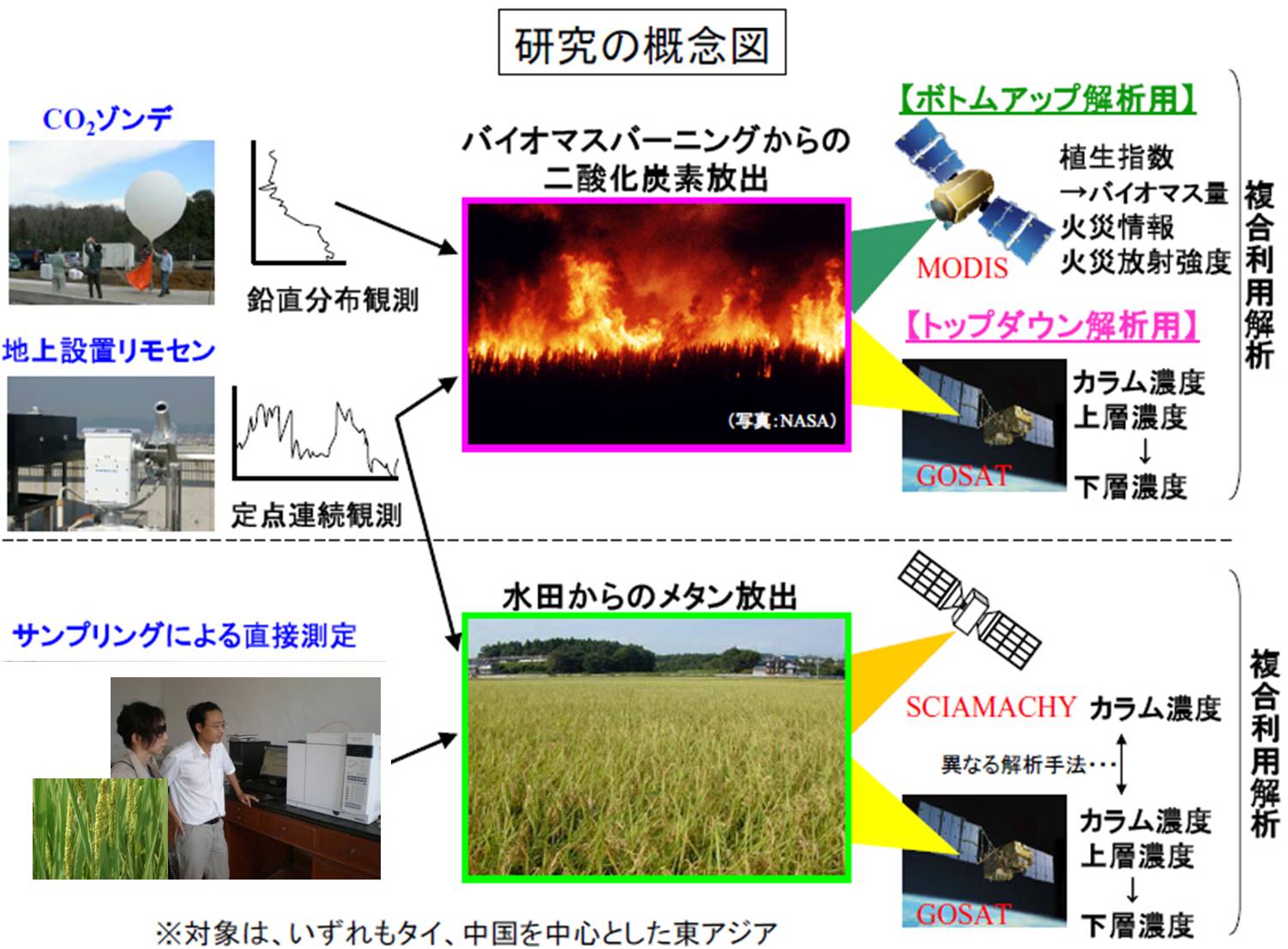Research Outline
Research Contents
We create a new coordinated database about CO2 emissions by utilizing synergy of data such as MODIS surface/vegetation data (bottom up analysis data), GOSAT greenhouse gases concentration data (top down analysis data), and data from sonde and ground-based measurements. In East Asia, despite the large contribution of CO2 from biomass burning such as swidden, peat fire, and forest fire, because of its large uncertainty, we create a database regarding this. Especially, while trying to retrieve the lower concentration by simultaneous analysis of vertical integrated quantity and the upper concentration, we conduct process study about three-dimensional construction of material transport by integrated analysis of vertical profiles recognized by CO2 sonde. We conduct continuous observation by ground-based remote sensing, and input satellite dataset mutually complemented into data integrated/analysis system (DIAS) again. Regarding CH4 concentration at high concentration sources such as paddy fields in East Asia, we analyze to understand the characteristics, and create a new dataset mutually compared/corrected by integrated utilization of satellite sensor of different wavelength and analysis methods such as SCIAMACHY or GOSAT-TANSO. At the high concentration area with large emission sources such as Sichuan Basin in China, we conduct direct observation by sampling, and validate a developed satellite data analysis method. At the same time, we develop a method to estimate lower concentration by simultaneous analysis of various wavelengths, and conduct the fresh attempt to create lower dataset at high concentration areas involving more information about emission sources. Regarding the development of human resources and training of young researchers, a seminar will be held once a year about satellite data analysis method and recent research trend. Especially, we aim to expand research boundaries about greenhouse gas such as CO2, and to stimulate global warming research in Japan by holding intelligible sessions as well as the development of software tool, to utilize dataset of various satellites.
Achievement Objectives
・ Regarding CO2 from biomass burning, by the integrated analysis of satellite data, to create the consistent dataset of 1) the emissions based on the estimated biomass quantity 2) the emissions estimated by fire radiative power 3) the atmospheric concentration by the interferometric monitor for greenhouse gases , and to reveal the characteristics of CO2 emissions from biomass burning in East Asia.
・ To retrieve a key parameter about the vertical structural analysis of material transport based on the vertical concentration observation by CO2 sonde and the continuous observation data by ground-based remote sensing.
・ To develop a method to retrieve the lower concentration by simultaneous analysis of the CO2 vertical integrated quantity and the upper concentration, and to create a lower concentration database in the biomass burning area.
・ To recognize the characteristics at the CH4 high concentration area in East Asia by integrated utilization of satellite sensor of different wavelength and analysis methods. Especially, to develop the lower concentration analysis method by simultaneous analysis of multiple wavelength, and to create the lower area dataset at the high concentration area.
・ To verify the satellite data analysis method such as CH4 lower concentration analysis method developed in this research by the direct sampling at the CH4 high concentration area.
・ To hold a seminar once a year about satellite data analysis method and recent research progress, targeting young researchers and students as audience. In addition, to hold workshops to use the software developed to open.
Expected effects
・ Regarding CO2 emissions from biomass burning, to improve the source database, which is said to be denigrated, by satellite data analysis backed by integrated approach and validated data, and to achieve to input more reliable dataset, which will contribute to carbon cycle research in East Asia.
・ To construct the basic dataset, which is necessary to advance an agricultural method for future curving CH4 emissions, by recognizing the characteristics of emissions from paddy fields, which is the major factor of CH4 emissions in East Asia.
・ To contribute to the increase of new researchers involved into this research field and the improvement of the beginner's general foundation.
・ To increase the researchers' utilization of database, and to expand environmental research boundaries in Japan.

